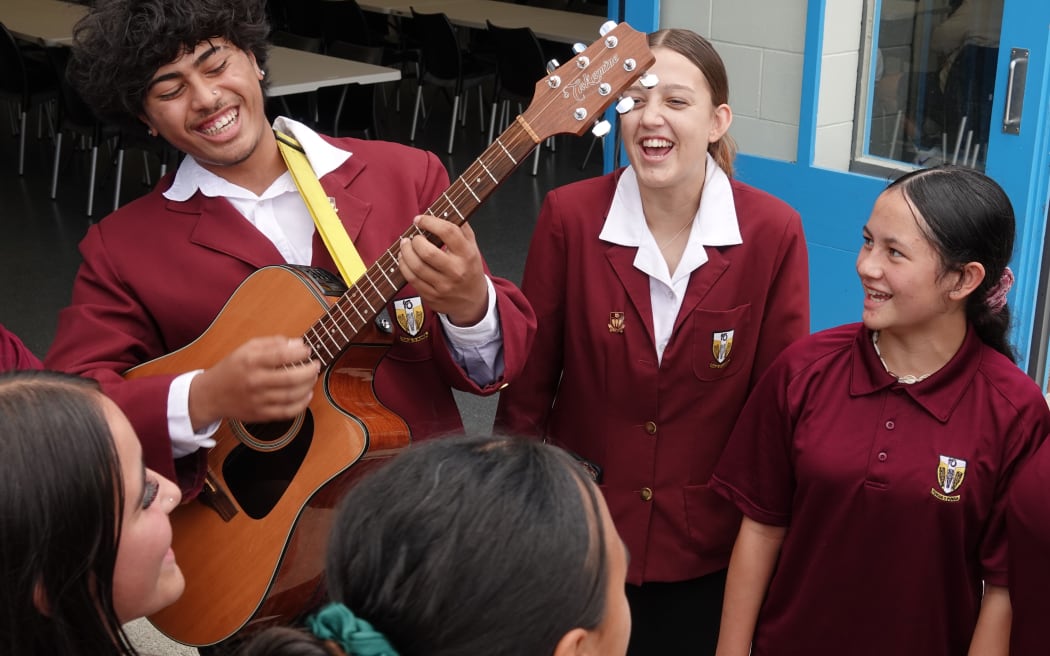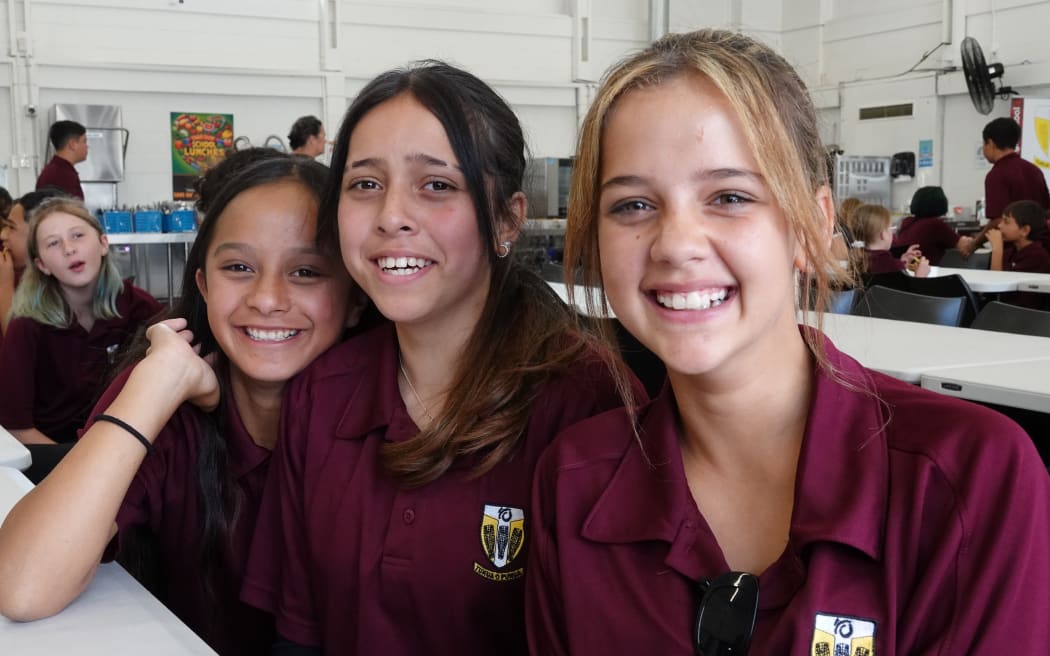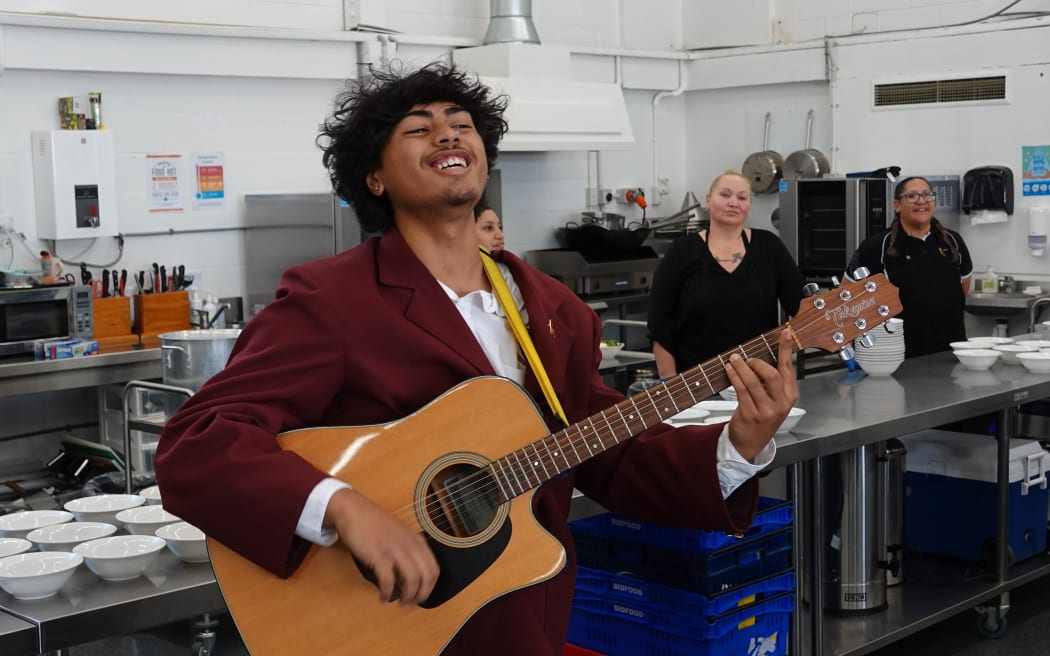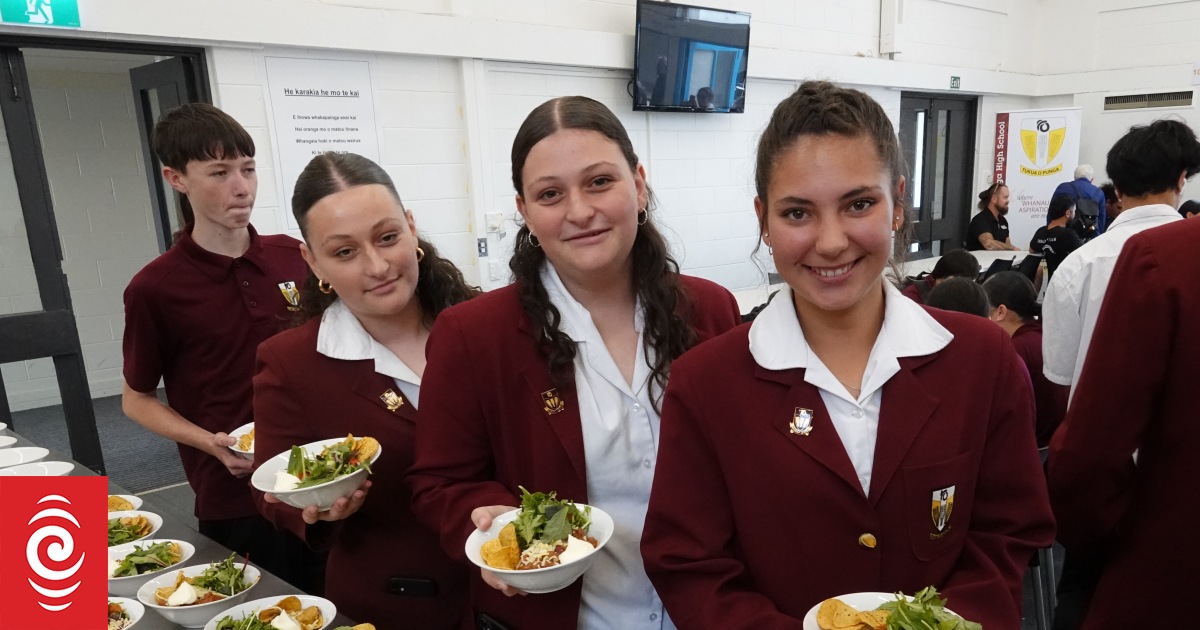
Senior students line up for nachos at Tikipunga High School.
Photo: Peter de Graaf
A Northland school is urging the government to rethink its plans to cut back the free lunches programme, saying the meals have greatly improved student attendance and behaviour.
The Ka Ora, Ka Ako programme – which feeds about 230,000 students a day at just under 1000 schools around the country – is up for review as part of next month’s Budget.
Associate Health Minister David Seymour has previously told RNZ its funding could be cut by as much as 50 percent, and has questioned its effectiveness and value for taxpayers.
The programme costs about $325 million per year.
However, some schools are deeply concerned about possible cuts to the scheme, as are some health and child poverty advocates.
Those concerns prompted Tikipunga High School, in Whangārei, to open up its lunchroom on Thursday to politicians, media, teacher unions, and organisations such as Health Coalition Aotearoa.
Principal Emma Leyland said her message to the government was to keep school lunches, “because they were making a real difference”.
Leyland said the school closed its tuck shop and started providing healthy meals 10 years ago, but that initiative was limited because the school had to rely on donations of food.

Year 7 and 8 students line up for nachos in the Tikipunga High School wharekai.
Photo: Peter de Graaf
Since 2019, Ka Ora, Ka Ako had allowed every child to be provided with a nutritious meal every day, she said.
A Treasury report released last year did not find evidence of improved achievement or attendance at schools receiving the lunches, but Leyland said it had brought huge benefits to her school.
“Attendance has improved, achievement has improved, behaviour has improved, and of course relationships have improved. Staff sit and eat with the children, and practice whakawhanaungatanga [relationship building], which is really important to us.”

Prefect Kaian Burt, 17, leads his schoolmates in a post-lunch waiata.
Photo: Peter de Graaf
Waste was not an issue at Tikipunga High, because the number of meals cooked was tailored to the number of students present each day, and the few scraps that were left went to a local pig farm.
The sit-down meals were served in three shifts of 120 students each, with a karakia and real plates and cutlery.
Leyland said a whānau survey last week found it had made “a real difference” to families.
Much of that was due to the high cost of living, which forced families to choose which essentials they could afford and those they could not.

Year 7 and 8 students at Tikipunga High School line up for a squirt of sweet chili sauce on their nachos.
Photo: Peter de Graaf
As well as relieving financial pressure, whānau said it encouraged children to go to school and the food provided was often healthier than they could afford at home.
A surprising finding was it had helped students who had been too shy to eat in front of others.
“There is a need for free school lunches, and we need to resource that need. If we don’t, we’ll be resourcing the consequences. School lunches work. Kids with full bellies learn better,” Leyland said.

Tikipunga High students at lunchtime, from left, Lahnelle Clark, 12, Trelise Wijohn, 11, and Dante Burgher, 12.
Photo: Peter de Graaf
Year 13 student Aamea Walding-King said many children relied on school lunches as their main source of food for the day.
“If that was taken away, it would make kids less focused in class. They’d just be thinking about food, but they won’t actually have any, so they won’t concentrate on their work.”
Kaian Burt, also Year 13, said communal meals were also a chance for busy senior students to reflect on their work and catch up with friends.
“And for some kids, this might be their only meal, for a few days even,” he said.

Burt leads a waiata of thanks for the cooks.
Photo: Peter de Graaf
As for the food, it was “amazing”.
“Our chefs are really good, eh. It puts a smile on everyone’s face.”
Health Coalition Aotearoa executive director Faye Langdon said free lunches allowed children to attend school and achieve, especially in areas with high deprivation.
They were also good for social development and behaviour.
Her group was “extremely concerned” by the prospect of cuts to free lunches, and had so far gathered 26,000 signatures calling for the programme to be not just kept but expanded.
“Children need full stomachs to learn,” she said.
Tim Howard, of Whangārei Child Poverty Action Group, said research had demonstrated the benefits for mental health, attendance and student focus.
Earlier, David Seymour said 10,000 lunches were wasted daily, and there was no hard evidence the programme improved school attendance or achievement.
He said the government was committed to improving the cost-effectiveness of the school lunches programme, which he said the Labour government had left unfunded from 2024.
“We’re looking at the evidence we do have and the feedback we get from the community in order to make a decision that balances the country’s books and the expectations people have around the taxpayer-funded school lunch programme,” Seymour said.
“It’s worth noting – for those who say we shouldn’t be making savings – that the success of the programme isn’t going to be defined by the number of taxpayers’ dollars spent. Success will ultimately be defined by whether kids are getting to school and learning, and taxpayers are getting value for their money.”
Seymour said he would announce a programme that delivered for both students and taxpayers as part of the upcoming Budget.
Ka Ora, Ka Ako targets the 25 percent of schools where students face the biggest socio-economic barriers and are most likely to arrive at school with an empty stomach.
In Northland, the programme caters to about 18,000 students at 115 schools.
Schools can decide whether to make their own lunches or contract to an external supplier.
Incidentally, the most popular lunch at Tikipunga High, by almost unanimous agreement, is butter chicken.
Tikipunga High School has 360 pupils, about 85 percent of whom are Māori.




